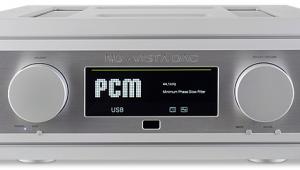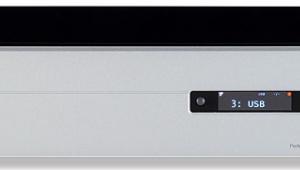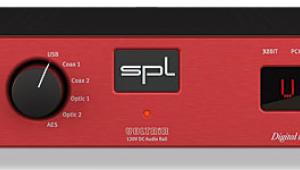Musical Fidelity M6x DAC/Headphone Amplifier Page 2
![]() Rich Pickings
Rich Pickings
Musical Fidelity by name, musical fidelity by nature? Certainly, the M6x has a sound – unfatiguing but precise, rich yet clear, lively yet not hysterical – that's beautifully well-judged and surely everything buyers at the price could hope for. Any grumbling on my part about the lack of networking – or the size of those status lights – was forgotten from the moment I began auditioning. This DAC rams home the 'outboard' concept with panache.
The production of Fleetwood Mac's Rumours [Rhino Records, 96kHz/24-bit] was apparently beset by technical difficulties, but I've always had a soft spot for the resulting sound, particularly when it comes to the tight, almost confined nature of the mix and the presentation of Stevie Nicks' vocals. Listening to the album through the M6x, it became hard to do anything but listen, such was the sense of detail and directness that was evoked.
The closing track 'Gold Dust Woman' featured crisply struck cowbell stage right and guitar and electric harpsichord sounds with scads of texture, while Nicks' plaintive verses had just the right mix of fragility and power. The M6x seemed to find each and every aspect and amplify it, without getting in the way of the overall mood and rhythm of the piece. The equally emotive 'Dreams', meanwhile, showcased a lush low-end. John McVie's simplistic two-note bassline was delivered with a warmth and body that acted as a canvas for lighter, airier elements to bounce off.

In Numbers
Of the M6x's filters, the differences between numbers 1-7 are subjectively slight, which makes the impact of the 'low latency' filter (number 8) all the more noticeable – with this in play, the DAC acquired a richer, plumper tone. Subsequently, there was more resonance to the acoustic bass in Antonio Forcione & Sabine Sciubba's 'When We Two Parted' [Meet Me In London, Naim Label; 192kHz/24-bit] than with any of the Sabre DACs' filters, but there was also a softening of the edges to the sultry vocals.
Generally, I preferred this mode, but not to the point where I would always head to it, and with MQA sources it's not possible to select a filter. (Incidentally, the only hiccup during my time with the M6x was when it initially reported an input signal of 44.1kHz with MQA via Tidal, but this was fixed in the settings of my desktop PC. Otherwise, I found this unit brilliantly uncomplicated to use).
Taking Charge
The delicate modern jazz of Forcione left me in little doubt that Musical Fidelity's no-frills DAC had the lightness of touch to convey every string pluck and vocal inflection without smearing them. It sounded pristine and utterly refined, yet this doesn't mean your hard rock and heavy metal library – presuming you have one – is off limits. On the contrary, the M6x charged its way through up-tempo guitar-driven music with glee, maintaining harsh edges when appropriate, and letting distortion live and breathe.
Judas Priest's 'Rapid Fire', from 1980's British Steel [Sony Music; Tidal Master], lived up to its name as pounding drums did battle with fast-fret pyrotechnics and Rob Halford's trademark operatic vocals. The M6x conveyed it with all the snarling fury the band surely intended from their album opener.

Switching to 'Madness', from Muse's The 2nd Law [Warner Bros. Records; 96kHz/24-bit], I started to further appreciate just what the M6x could do. This piece starts out sparsely, with a synthesised bassline and minimalist drum pattern, but eventually blossoms into uplifting rock. I found I had closed my eyes, partly so I could be fully immersed in the weight and scale of the euphoric closing bars, but also to revel in the DAC's subtle imaging of the song's backing vocals, which moved in a gentle arc across the soundstage. It was a compelling performance of precision and separation that, in truth, made me quite emotional… until the dynamic funk rhythms of following track 'Panic Stations' shocked me out of my reverie!
Sweet Flurry
Johnny Cash's American IV… [American Recordings 063 339-2], via CD into the DAC's optical input, brought deep, well-worn vocals and stage-filling piano to the M6x party, while Rodgers and Hammerstein's Sound Of Music soundtrack [RCA; 44.1kHz/16-bit download] was all about the sweet flurry of strings in the overture, and the glassy, enunciated vocal of Julie Andrews in 'My Favourite Things'. If Maria von Trapp had heard the M6x, it would surely have gone straight into that list, alongside whiskers on kittens and raindrops on roses…
Hi-Fi News Verdict
Move along if you're after a networked DAC for your system, but demand an audition of the M6x if you can handle a little cable clutter. Musical Fidelity's latest converter is a winning combination of foolproof usability, wide file compatibility and accomplished performance that favours any musical genre. Add in the eminently sensible price tag, and this full-width DAC has serious X appeal.


















































